Abstract
Cancer immunotherapy targeting mesothelin represents a potentially plausible approach for the control of ovarian cancer as most ovarian cancers express high levels of mesothelin. In the current study, we created a mesothelin-positive luciferase-expressing ovarian cancer model, MOSEC/luc. This luciferase-expressing tumor model allowed us to quantitate tumor distribution and tumor load in tumor-challenged mice using a non-invasive bioluminescence imaging system. In addition, we identified an H-2Db-restricted mesothelin peptide-specific cytotoxic T-lymphocyte (CTL) epitope (amino acid (aa) 406–414) that was endogenously processed and presented by MOSEC/luc tumor cells. We showed that adoptive transfer of mesothelin peptide (aa406–414)-specific CD8+ T cells led to the control of MOSEC/luc tumor cells. The MOSEC/luc tumor model and the newly identified H-2Db-restricted murine mesothelin-specific CTL epitope (aa406–414) will be very useful for the development of immunotherapy for ovarian cancer as well as for the development of quantitative CD8+ T cell-mediated immunological assays.
This is a preview of subscription content, access via your institution
Access options
Subscribe to this journal
Receive 12 print issues and online access
$259.00 per year
only $21.58 per issue
Buy this article
- Purchase on Springer Link
- Instant access to full article PDF
Prices may be subject to local taxes which are calculated during checkout






Similar content being viewed by others
References
Ozols RF . Systemic therapy for ovarian cancer: current status and new treatments. Semin Oncol 2006; 33: S3–S11.
Pfisterer J, Ledermann JA . Management of platinum-sensitive recurrent ovarian cancer. Semin Oncol 2006; 33: S12–S16.
Bhoola S, Hoskins WJ . Diagnosis and management of epithelial ovarian cancer. Obstet Gynecol 2006; 107: 1399–1410.
Coukos G, Conejo-Garcia JR, Roden RB, Wu TC . Immunotherapy for gynaecological malignancies. Expert Opin Biol Ther 2005; 5: 1193–1210.
Scholler N, Fu N, Yang Y, Ye Z, Goodman GE, Hellstrom KE et al. Soluble member(s) of the mesothelin/megakaryocyte potentiating factor family are detectable in sera from patients with ovarian carcinoma. Proc Natl Acad Sci USA 1999; 96: 11531–11536.
Hassan R, Bera T, Pastan I . Mesothelin: a new target for immunotherapy. Clin Cancer Res 2004; 10: 3937–3942.
Roby KF, Taylor CC, Sweetwood JP, Cheng Y, Pace JL, Tawfik O et al. Development of a syngeneic mouse model for events related to ovarian cancer. Carcinogenesis 2000; 21: 585–591.
Shen Z, Reznikoff G, Dranoff G, Rock KL . Cloned dendritic cells can present exogenous antigens on both MHC class I and class II molecules. J Immunol 1997; 158: 2723–2730.
Parker KC, Bednarek MA, Coligan JE . Scheme for ranking potential HLA-A2 binding peptides based on independent binding of individual peptide side-chains. J Immunol 1994; 152: 163–175.
Kim TW, Lee JH, He L, Boyd DA, Hardwick JM, Hung CF et al. Modification of professional antigen-presenting cells with small interfering RNA in vivo to enhance cancer vaccine potency. Cancer Res 2005; 65: 309–316.
Conejo-Garcia JR, Benencia F, Courreges MC, Kang E, Mohamed-Hadley A, Buckanovich RJ et al. Tumor-infiltrating dendritic cell precursors recruited by a beta-defensin contribute to vasculogenesis under the influence of Vegf-A. Nat Med 2004; 10: 950–958.
Orsulic S, Li Y, Soslow RA, Vitale-Cross LA, Gutkind JS, Varmus HE . Induction of ovarian cancer by defined multiple genetic changes in a mouse model system. Cancer Cell 2002; 1: 53–62.
Xing D, Orsulic S . A mouse model for the molecular characterization of brca1-associated ovarian carcinoma. Cancer Res 2006; 66: 8949–8953.
Connolly DC, Bao R, Nikitin AY, Stephens KC, Poole TW, Hua X et al. Female mice chimeric for expression of the simian virus 40 TAg under control of the MISIIR promoter develop epithelial ovarian cancer. Cancer Res 2003; 63: 1389–1397.
Dinulescu DM, Ince TA, Quade BJ, Shafer SA, Crowley D, Jacks T . Role of K-ras and Pten in the development of mouse models of endometriosis and endometrioid ovarian cancer. Nat Med 2005; 11: 63–70.
Tseng JC, Levin B, Hurtado A, Yee H, Perez de Castro I, Jimenez M et al. Systemic tumor targeting and killing by Sindbis viral vectors. Nat Biotechnol 2004; 22: 70–77.
Tseng JC, Hurtado A, Yee H, Levin B, Boivin C, Benet M et al. Using sindbis viral vectors for specific detection and suppression of advanced ovarian cancer in animal models. Cancer Res 2004; 64: 6684–6692.
Jenkins DE, Oei Y, Hornig YS, Yu SF, Dusich J, Purchio T et al. Bioluminescent imaging (BLI) to improve and refine traditional murine models of tumor growth and metastasis. Clin Exp Metastasis 2003; 20: 733–744.
Drake JM, Gabriel CL, Henry MD . Assessing tumor growth and distribution in a model of prostate cancer metastasis using bioluminescence imaging. Clin Exp Metastasis 2005; 22: 674–684.
Harrer T, Harrer E, Barbosa P, Kaufmann F, Wagner R, Bruggemann S et al. Recognition of two overlapping CTL epitopes in HIV-1 p17 by CTL from a long-term nonprogressing HIV-1-infected individual. J Immunol 1998; 161: 4875–4881.
Currier JR, deSouza M, Chanbancherd P, Bernstein W, Birx DL, Cox JH . Comprehensive screening for human immunodeficiency virus type 1 subtype-specific CD8 cytotoxic T lymphocytes and definition of degenerate epitopes restricted by HLA-A0207 and -C(W)0304 alleles. J Virol 2002; 76: 4971–4986.
Hung CF, Calizo R, Tsai YC, He L, Wu TC . DNA vaccine encoding a single-chain trimer of HLA-A2 linked to human mesothelin peptide generates anti-tumor effects against human mesothelin-expressing tumors. Vaccine 2007; 25: 127–135.
Yokokawa J, Palena C, Arlen P, Hassan R, Ho M, Pastan I et al. Identification of novel human CTL epitopes and their agonist epitopes of mesothelin. Clin Cancer Res 2005; 11: 6342–6351.
Thomas AM, Santarsiero LM, Lutz ER, Armstrong TD, Chen YC, Huang LQ et al. Mesothelin-specific CD8(+) T cell responses provide evidence of in vivo cross-priming by antigen-presenting cells in vaccinated pancreatic cancer patients. J Exp Med 2004; 200: 297–306.
Wang TL, Ling M, Shih IM, Pham T, Pai SI, Lu Z et al. Intramuscular administration of E7-transfected dendritic cells generates the most potent E7-specific anti-tumor immunity. Gene Therapy 2000; 7: 726–733.
Chen CH, Wang TL, Hung CF, Yang Y, Young RA, Pardoll DM et al. Enhancement of DNA vaccine potency by linkage of antigen gene to an HSP70 gene. Cancer Res 2000; 60: 1035–1042.
Ji H, Wang TL, Chen CH, Pai SI, Hung CF, Lin KY et al. Targeting human papillomavirus type 16 E7 to the endosomal/lysosomal compartment enhances the antitumor immunity of DNA vaccines against murine human papillomavirus type 16 E7-expressing tumors. Hum Gene Ther 1999; 10: 2727–2740.
Brown CE, Wright CL, Naranjo A, Vishwanath RP, Chang WC, Olivares S et al. Biophotonic cytotoxicity assay for high-throughput screening of cytolytic killing. J Immunol Methods 2005; 297: 39–52.
Acknowledgements
We thank Dr Richard Roden for helpful discussions. We gratefully acknowledge Roanne Calizo and Archana Monie for the preparation of the manuscript. This work was supported by ovarian cancer Grants from the Alliance for Cancer Gene Therapy (ACGT) and the NCDGG (1U19 CA113341–01).
Author information
Authors and Affiliations
Corresponding author
Rights and permissions
About this article
Cite this article
Hung, CF., Tsai, YC., He, L. et al. Control of mesothelin-expressing ovarian cancer using adoptive transfer of mesothelin peptide-specific CD8+ T cells. Gene Ther 14, 921–929 (2007). https://doi.org/10.1038/sj.gt.3302913
Received:
Revised:
Accepted:
Published:
Issue Date:
DOI: https://doi.org/10.1038/sj.gt.3302913
Keywords
This article is cited by
-
Induced pluripotent stem cell-derived dendritic cell vaccine therapy genetically modified on the ubiquitin-proteasome system
Gene Therapy (2023)
-
Preservation of tumor-host immune interactions with luciferase-tagged imaging in a murine model of ovarian cancer
Journal for ImmunoTherapy of Cancer (2015)
-
Intraperitoneal delivery of paclitaxel by poly(ether-anhydride) microspheres effectively suppresses tumor growth in a murine metastatic ovarian cancer model
Drug Delivery and Translational Research (2014)
-
Control of spontaneous ovarian tumors by CD8+ T cells through NKG2D-targeted delivery of antigenic peptide
Cell & Bioscience (2013)
-
Innovative DNA vaccine for human papillomavirus (HPV)-associated head and neck cancer
Gene Therapy (2011)



